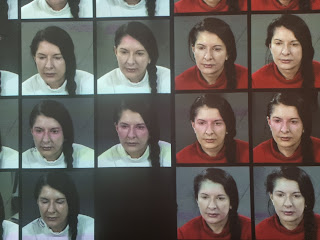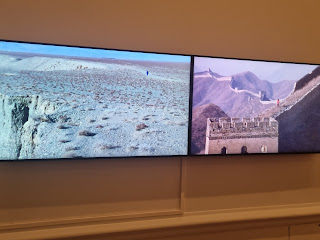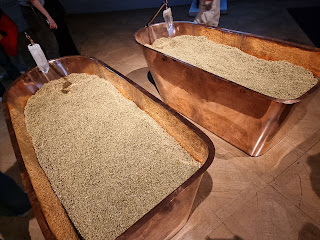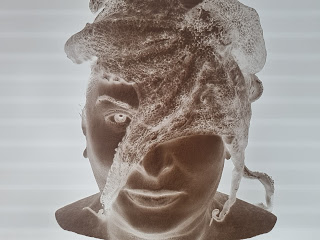"I don't have tattoos. I have scars" - Marina Abramovic

Five Stages of Maya Dance (2013/2016)
You can say what you like about Marina Abramovic and her art but you can't say she doesn't mean it and you can't say she hasn't suffered for it. The Royal Academy's ongoing retrospective of her work shows how she has, over the decades, pushed both her body and her mind to the extremes in an attempt, usually successful, to make thought provoking, disturbing, and interesting work.
Even as a viewer you will be tested in places. There are videos that are uncomfortable to look at because of the violent, or potentially violent, content and there are videos that are uncomfortable to look at because they go on so bloody long. There are films on show at the RA that last for two hours and there are works, now captured for posterity, that lasted for between two and three months. Abramovic puts the hours in alright.
Born in Belgrade, Yugoslavia (now Serbia) in 1946, Abramovic studied in Belgrade and Zagreb as an academic painter but by the time she'd reached her twenties she'd been inspired by radical politics and radical art and moved from paintbrushes to performance art. Eventually becoming one of the key players in that movement. Along with Nam June Paik, Carolee Scnheeman, Chris Burden, Vito Acconci, and Joseph Beuys.
Her medium, for a lot of her work, is that of her own body. Its physical qualities as well as its 'energy' and though the 'performance' is at the heart of her work she expands on this with photographs, sculptures, videos, and installations. She is what you may call a multidisciplinary artist and she is one that is interested in using her art to provide emotional and spiritual (not my favourite word) transformation in both herself and the viewer.
The Artist Is Present (2010)
The Artist Is Present (2010)
I can't, honestly, say I was either emotionally or spiritually transformed by this exhibition at this point (though I enjoyed it) but that's probably because I was looking at videos of past performances rather than the performances themselves. If I'd been at them it might have been different. I would certainly have felt awkward and uncomfortable at times.
Take 2010's The Artist Is Present. Abramovic sat for seventy-five days at a table in the atrium of New York's Museum of Modern Art and invited members of the public, 1,545 of them eventually, to sit in front of her in silence for as long as they wished. Yes, like the stare out championships on Big Train. Abramovic herself seems to have remained, for the most part, poker faced while the general public, on a big screen on a wall opposite a grid of Abramovic's face, either look amused, confused, distressed, or even nonplussed by it all.
Extreme duration aside, it's pretty tame compared to what she was getting up to nearly four decades earlier. 1974's Rhythm O saw Abramovic present herself as an object to be acted upon. She stood motionless for eight hours alongside a table of seventy-two items that could be used for either pain or pleasure and asked audience members to do what they wish with her and with those objects on the table.
Considering some of those objects are hammers and saws that was something of a risk. What would you do if you were in the audience? I really don't know what I would but I don't think it would involve either a hammer or a saw. Apparently, the audience were, initially, hesitant to get involved but once they did some of them stripped Abramovic to her waist, cut her skin open, and, in one case, held a gun to her neck. The trauma of it all turned some of Abramovic's hair white and at the end of the performance many of the audience fled the gallery. Presumably ashamed of the violent behaviour they had been allowed themselves to become part of.
Rhythm O (1974)
Rhythm O (1974)
Rhythm O (1974)
For Abramovic, her Balkan identity was bound up in extremes of violence and eroticism so it seemed natural, and correct, that she should express this in her art. Her parents, Danica Rosic and Vojin Abramovic had been partisan fighters in
World War II and, feted as heroes, had been rewarded with coveted state jobs. The communist era she grew up in had an ideology of strict physical discipline paired with restricted freedom of speech and even though she left Belgrade, and Yugoslavia, in 1976 she continued to feel close ties to the land of her birth.
In 1997, at the Venice Biennale, she presented Balkan Baroque - a response to a decade of war and violence in a broken, and breaking, up Yugoslavia. The pile of bones, to anyone with even a cursory knowledge of the bloody wars that took place in the region at the time, hardly needs explanation and Abramovic, it seems, did not only mourn the loss of life but the loss her father and the loss of Yugoslavia itself. In 2001's The Hero she sits astride a white horse while the Yugoslavian national anthem is sung.
Balkan Baroque (1997)
Freeing the Horizon (1971)
The Hero (2001)
I'm not quite sure what the trough of ink (part of Balkan Baroque) is meant to represent but I suspect it is all the blood spilled in the Balkan conflicts of the time. It's almost a surprise that Abramovic didn't use real blood as it's not a medium she's shied away from in the past (Rhythm O). A year before Rhythm O, Abramovic staged her first performance, Rhythm 10.
There's not a lot of it on show at the
RA (despite the exhibition being pretty vast) but there is a still from a film of Abramovic doing that thing where you stab a knife into a table between the fingers of your splayed hand. It's not recorded if she managed to do this without stabbing herself but sometimes, it seems, the action is enough on its own.
She considered the pain and
anxiety she experienced during these performances and decided they were not the goal of the work. The goal was, she mused, the extreme mental clarity and presence she experienced while going through it. A kind of catharsis, a hardcore way of living precisely in the moment. Which is disarmingly similar to the reasons you may hear for somebody self-harming.
Not long after this she met with the German artist Frank Uwe Laysiepen who worked under the name of Ulay. They became a couple both romantically and artistically and for thirteen years they worked together as a partnership.
The Royal Academy's largest room is full of films they've made together. You'd need to take a week off work to watch them all (which I, of course, didn't) but the general gist is that Ulay and Abramovic's work became not about the self alone but about the self and its relationship to the other.
Freeing the Voice (1975)
AAA-AAA (1978)
Lips of Thomas (1975)
Relation in Time (1977)
Rest/Energy (1980)
Ulay and Abramovic tie their hair together, they scream at each other, and they breath intensely close to each other but the most powerful work was, for me, 1980's Rest/Energy in which he holds a bow and arrow directed straight at her for four minutes. A microsecond of distraction and it could all have ended very badly. It is an image of pure trust and pure love and as with pure love and pure trust it is fraught with a sense of 'what if'. It's one of the best works in the entire exhibition.
Eight years later, however, Ulay and Abramovic embarked on an epic project that would bring them to realise that their relationship was over. Starting from opposite ends of the Great Wall of China, they would each walk for ninety days and meet in the middle. The plan was for them to marry at that point but by the time the Chinese authorities had granted them permission for the performance their relationship had deteriorated.
The show, however, must go on. So the work was modified. Both artists, as planned, walked along the Great Wall of China for ninety days and met in the middle. But instead of getting married as originally planned, they underwent a ritualised separation. Both their romantic and their personal relationship came to an end and was never revived - though when Ulay died in March 2020, Abramovic spoke fondly of their time together.
The art on show to reflect this era is surprisingly modest. Some Chinese vases whose individuality Abramovic believes reflects her and Ulay going their own ways, some rubbings taken on and around the wall that Abramovic said reflected the historical energy of those that had gone before, and a fifteen minute video film of the two of them walking along the wall.
Modus Vivdeni:Urn 1, Urn 2, Veil, and Urn 3 (c.1983)
The Sun and the Moon (Die Mond, der Sonne) (1987)
The Lovers, Great Wall Walk (1988)
After the Great Wall walk, and her split with Ulay, Abramovic's art started moving away from the visceral and confrontational to something more reflective and elegiac. She became ever more interested in exploring the relationship between material and immaterial energy. Inspired by a myth that the Great Wall of China was built in the shape of a dragon's tail she filmed herself with a snake crawling across her face and she made a series of works, Transitory Objects for Human Use', which made the viewer, not for the first time in her career, part of the work. An example would be 1989's Green Dragon (below) in which you can lie down and (try to) feel the energy of the piece.
While I was there, people were filming their friends and their partners posing on these works and I felt I was missing out.
Visiting galleries on my own,
as I often (
but not always)
do, is not really a problem but when you see works like this you realise you are missing out and it makes you thing of other things you're missing out on in life. Having a job, having a partner, having a child. Having a life, basically.
Still, lots of time to write
blogs and lots of time to convene with nature at one's own pace. Which is something I think Abramovic would approve of. For her, nature is the source and she was particularly attracted to places she saw as having magnetism and energy:- waterfalls, volcanoes, faults in the Earth, great rock formations. Places that inspired awe. Places that humans seem almost determined to destroy as if to prove it is they, not nature, that has dominion over the planet. Humans will fail in this folly.
Sleeping Under the Banyan Tree (2010)
Stromboli III Volcano (2002)
Dragon Heads (1990/2018)
The natural environment, without human intervention, changes slowly and, for Abramovic, time does too. She likes to stretch a moment of time to its limits. We only live for a finite amount of time so we should try and appreciate every second, even if we are not in a happy moment. In Five Stages of Maya Dance, Abramovic considers extremes of human expression (using photographs carved into alabaster slabs, it works, I've headed the blog up with one of them) and Cleansing the Mirror sees Abramovic pondering the death that awaits us all.
Some of us sooner than others. Abramovic believes death to be "the ultimate physical transition that all of us will undergo" and has said that "when death knocks" on her door, she wants "to enter this last experience very consciously and free from fear, bitterness and anger" because "it is the last experience that we can have in our lives".
Earlier today I read a Guardian interview with
Shane MacGowan's widow Victoria Mary Clarke and in it she spoke of Shane's recent death at the age of 65. She said, with no little understatement, that "Shane loved getting high when he was alive and I think the ultimate high for him would have been to ascend, and meet Jesus, and really get off on that cosmic space. That would have been the eternal buzz". It seemed a nice way to speak about the death of a loved one and though
I don't share Shane's belief in God, I do hope that death is more a merciful release than a long, drawn out, painful experience. Like
my friend Bugsy, I hope I can leave this Earth with kind words for all around me and all I wish to leave behind is love and memories - and maybe the odd blog!
Cleansing the Mirror I (1990)
Artist Portrait with a Candle (A) (2012)
Five Stages of Maya Dance (2013/2016)
Five Stages of Maya Dance (2013/2016)
Five Stages of Maya Dance (2013/2016)
Four Crosses (2019)
Four Crosses (2019)
Bed for Dead Spirits (1996)
Let's get away from me and back to Marina Abramovic. Cleansing the Mirror sees a video of somebody slowly and methodically cleaning a skeleton. The bones that are left when the soul has departed. It's an act of pure devotion, an act that is as sad as it is inspiring.
As we get older, we view death differently. When we're young it's something violent and extreme and it's, mostly, something that happens to other people, to older people. As we age, we see our friends and close family members pass away and we begin to consider, more and more, our own mortality. The best we can hope for is to come to terms with it before our time is up. Marina Abramovic is 77 years old. I hope she's got many years left but it does seem she has come to terms with her eventual death.
As if to demonstrate that the exhibition was moving away from this mortal coil and into some kind of afterworld there was a portal us visitors could walk through. I did. I didn't feel much but it looked cool.
Our whole lives are spent passing through thresholds and entering into different states of being. For Abramovic, portals (either artworks or actual) are about changed states of consciousness, about being able to cope with pain, about being able to enter
a state of dreaming.
Portal (2022)
The Communicator (3) (2012/2023)
The Spirit in Any Condition Does Not Burn (2011)
Yet for all this talk of spirituality, energy, and dream states Abramovic recognises there are limits to our consciousness and she reflects on this in her art. Ulay and Abramovic had spent time in the 1980s living with and studying the spiritual traditions of the Aboriginal people in Australia and Tibetan Buddhism.
They became, and she remains, interested in the stillness and energy concentration of these practices as well as their conception of space and time. Of being in a place where the past, the present, and
the future can all co-exist in harmony. The works that round off the show are an example of Abramovic, once drawn to the violent and the transgressive, coming to terms with life, slowing down, and absorbing all that there is to absorb. I particularly like Stromboli where the artist simply lies on a beach and lets the waves wash over her. Anyone who's ever done that will know how relaxing and therapeutic that feels. As long as the water is warm enough. I recommend a Caribbean beach (not that I've been to one for over twenty years).
Dozing Consciousness (1997)
Reprogramming/Levitation Module (2000/2008)
Stromboli (2002)
The Current (2017)
To me, it's one of the most uplifting experiences imaginable but many find uplift in spirituality or even in organised religion (which I have no time for). Abramovic found inspiration in the experiences of the cloistered nun and 16c Spanish mystic Teresa of Avila who, like Francis of Assisi (apparently), was so holy she could levitate.
While I don't believe this for one moment I do believe that art, and religion - if that's your bag, can uplift the human spirit. Marina Abramovic, in a show I'd had doubts about before attending, managed to uplift mine and now we are a week away from
Christmas I am looking forward to seeing
close friends and family and I know that, even more than art and definitely more than religion, that they will uplift my spirits even more. Srecni praznic.
Untitled Octopus (2) (2019)
The Levitation of Saint Therese, from The Kitchen (2009)
Chair for Human Use with Chair for Spirit Use (6) (2012)













































No comments:
Post a Comment